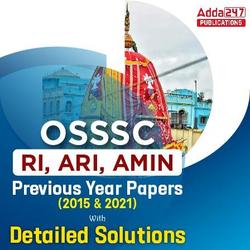The OSSSC LSI, Forester, or FG exams and seeking comprehensive preparation in Biology. We’ve compiled a curated list of the top 30 Biology (General Science) multiple-choice questions (MCQs) to aid in your exam readiness. Covering various aspects of biology, these questions delve into fundamental concepts, principles, and terminologies essential for success in your examination. Whether you’re focusing on cell biology, genetics, ecology, or physiology, this collection ensures a well-rounded understanding of the subject matter. With detailed explanations accompanying each answer, you’ll not only assess your knowledge but also enhance your understanding of key biological concepts. So, dive into these MCQs and embark on your journey towards acing the biology section of your OSSSC exams!
Top 30 Biology (General Science) MCQs for OSSSC LSI, Forester, FG
- Which of the following are the basic categories of chemical signaling found in multicellular organisms?
(a) Paracrine signaling
(b) Autocrine signaling
(c) Endocrine signaling
(d) All of the above
Sol: (d) All of the above. - Cell signaling is __________.
(a) Intercellular
(b) Intracellular
(c) Both (a) and (b)
(d) None of the above
Sol: (c) Both (a) and (b). - Which of the following signaling is involved in Paracrine signaling?
(a) Chemical signaling
(b) Synaptic transmission
(c) Hormonal Communication
(d) Autostimulation of cell
Sol: (a) Chemical signaling. - Octopus belongs to the class________.
(a) Mollusca
(b) Pelecypoda
(c) Cephalopoda
(d) None of the above
Sol: (c) Cephalopoda. - Which of the following statements is true about Mytilus?
(a) Mytilus belongs to class Arthropoda of phylum Mollusca
(b) Mytilus belongs to class Amphineura of phylum Mollusca
(c) Mytilus belongs to class Pelecypoda of phylum Mollusca
(d) Mytilus belongs to class Echinodermata of phylum Mollusca
Sol: (c) Mytilus belongs to class Pelecypoda of phylum Mollusca. - Which of the following statements is true about the weight of the human liver?
(a) 1.30 kg to 1.56 kg
(b) 1.44 kg to 1.66 kg
(c) 1.36 kg to 1.71 kg
(d) 1.68 kg to 1.86 kg
Sol: (b) 1.44 kg to 1.66 kg. - Which of the following is the function of the human liver?
(a) Production of bile
(b) Metabolization of fats
(c) Metabolization of carbohydrates
(d) All of the above.
Sol: (d) All of the above. - Cotton, wool, silk are examples of ____________ .
(a) Plant Fibres
(b) Animal Fibres
(c) Natural Fibres
(d) Synthetic Fibres
Sol: (c) Natural Fibres. - The fleece of the lamb refers to ____________ .
(a) A popular sheep breed
(b) The white colour of the fur
(c) Hairy fibres of the sheep
(d) All of the above
Sol: (b) The white colour of the fur. - Which of the following statements is true about the rearing of silkworms?
(a)The rearing of silkworms for obtaining silk is called silk
(b)The rearing of silkworms for obtaining silk is called the cocoon
(c)The rearing of silkworms for obtaining silk is called sericulture
(d)The rearing of silkworms for obtaining silk is called silviculture
Sol: (c)The rearing of silkworms for obtaining silk is called sericulture. - The different types of carbon compounds are _________.
(a) Lipids
(b) Nucleic acids
(c) Carbohydrates
(d) All of the above
Sol. (d) All of the above. - What is the total percentage of carbon present in the human body?
(a) 15 to 16 per cent
(b) 18 to 19 per cent
(c) 20 to 25 per cent
(d) None of the above
Sol. (b) 18 to 19 per cent. - Which of the following statements is true about carbon?
(a) Carbon is the main component of carbohydrates.
(b) Carbon is a major component of living beings.
(c) Carbon is one of the basic building blocks for organic life.
(d) All of the above
Sol. (d) All of the above. - The hormone Erythropoietin is produced in________.
(a) Liver
(b) Spleen
(c) Kidney
(d) Thyroid gland
Sol. (c) Kidney. - According to the diagnostics report, the normal plasma level of erythropoietin hormone ranges from ___________.
(a) 10 to 22 U/L
(b) 10 to 25 U/L
(c) 10 to 50 U/L
(d) 10 to 75 U/L
Sol. (a) 10 to 22 U/L. - Creutzfeldt-Jakob disease (vCJD) can be contracted only if _______.
(a) Consume nerve tissues (brain and spine) of cattle infected with Mad cow disease
(b) Consume shrimp infected with E.coli
(c) Consume water tainted with E.coli
(d) None of the above
Sol. (a) Consume nerve tissues (brain and spine) of cattle infected with Mad cow disease. - Which of the following CANNOT be transmitted via infectious droplets?
(a) Rubella
(b) Common cold
(c) Influenza
(d) None of the above
Sol. (d) None of the above. - Which of the following constitutes a fossil?
(a) A mineralized burrow of an extinct animal
(b) An unidentified animal found frozen in a glacier
(c) An ant found inside a block of amber, dating back to 110 million years
(d) All of the above
Sol. (d) All of the above. - Stephen J. Gould is a paleontologist who speculated that, of all the organisms that ever lived on earth, only ________% are still alive.
(a) 1
(b) 20
(c) 50
(d) 99
Sol. (a) 1 - Which cellular structure is exclusive to plant cells and absent in animal cells?
(a) Cytoplasm
(b) Vacuoles
(c) Mitochondria
(d) Cell wall
Sol: (d) Cell wall - Which organelle does not contain DNA?
(a) Nucleus
(b) Lysosomes
(c) Chloroplast
(d) Mitochondria
Sol: (b) Lysosomes - What is the primary component of the cell wall?
(a) Lipid
(b) Starch
(c) Protein
(d) Cellulose
Sol: (d) Cellulose - Which statement accurately reflects the Cell theory?
(a) The Cell theory does not apply to fungi
(b) The Cell theory does not apply to viruses
(c) The Cell theory does not apply to algae
(d) The Cell theory does not apply to microbes
Sol: (b) The Cell theory does not apply to viruses - When is World Health Day celebrated?
(a) 1st March
(b) 7th April
(c) 6th October
(d) 10th December
Sol: (b) 7th April - Which practices are included in personal hygiene?
(a) Sharing food
(b) Bathing twice a day
(c) Drinking boiled water
(d) Eating without washing one’s hand
Sol: (b) Bathing twice a day - Who coined the term “chromosome”?
(a) Sutton
(b) Boveri
(c) Waldeyer
(d) Hoffmeister
Sol: (c) Waldeyer - Where is the gene for color blindness located in males?
(a) X-chromosome
(b) Y-chromosome
(c) Both X and Y chromosome
(d) Either X-chromosome or Y-chromosome
Sol: (a) X-chromosome - Who proposed the chromosomal theory of inheritance?
(a) Sutton
(b) Boveri
(c) Correns
(d) Both (a) and (b)
Sol: (d) Both (a) and (b) - Which condition is referred to as a sex-linked disease?
(a) Leukemia
(b) Alzheimer’s
(c) Malignancy
(d) Color blindness
Sol: (d) Color blindness - Which of the following statements is true about the ends of the chromosome?
(a) The ends of the chromosome are called Satellites
(b) The ends of the chromosome are called Centromeres
(c) The ends of the chromosome are called Telomeres
(d) The ends of the chromosome are called Kinetochore
Sol: (c) The ends of the chromosome are called Telomeres.
















